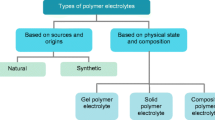Abstract
Poly(vinyl butyral) (PVB) is of particular interest because of its low cost, extremely wide temperature work range (− 20 to 120 °C), and efficient chemical stability. In this study, a gel polymer electrolyte (GPE) containing Li+ ions was fabricated by using dimethylacetylamine (DMA), lithium perchlorate (LiClO4), and PVB. The experimental results indicated that a highly transparent GPE with a high ionic conductivity (σ) could be obtained by mixing glue (DMA with a PVB content of 10 wt%) with a LiClO4 content of 6 wt%. It was found that the ionic conductivity (σ) of the GPE depended on the LiClO4 content, and the GPE with a LiClO4 content of 6 wt% exhibited a maximum σ of 7.73 mS cm−1, a viscosity coefficient of 3360 mPa s, and a transmittance greater than 89% (visible region) at room temperature. Furthermore, PVB improved the electrolyte solution leakage, and the LiClO4 was used as an ion supply source for the high σ of the GPE.






Similar content being viewed by others
References
Lin SY, Wang CM, Hsieh PT, Chen YC, Liu CC, Shih SC (2009) A novel gel polymer electrolyte based on lithium salt with an ethyl cellulose. Colloid Polym Sci 287:1355–1358
Ikeda Y (2000) Elastomeric poly(oxyethylene) matrixes for ion conduction. J Appl Polym Sci 78:1530–1540
Yue Z, McEwen IJ, Cowie JMG (2003) Novel gel polymer electrolytes based on a cellulose ester with PEO side chains. Solid State Ionics 156:155–162
Matsui S, Muranaga T, Higobashi H, Ionics S, Sakai T (2001) Liquid-free rechargeable Li polymer battery. J Power Sources 97:772–774
Murata K, Izuchi S, Yoshihisa Y (2000) An overview of the research and development of solid polymer electrolyte batteries. Electrochim Acta 45:1501–1508
Fu X (2010) Polymer electrolytes for electrochromic devices. In: Santos D, Sequeira C (eds) Polymer electrolytes. Elsevier, Cambridge, pp 471–523
Nguyen CA, Xiong S, Ma J, Lu X, Lee PS (2009) Toward electrochromic device using solid electrolyte with polar polymer host. J Phys Chem B 113:8006–8010
Porcarelli L, Gerbaldi C, Bella F, Nair JR (2016) Super soft all-ethylene oxide polymer electrolyte for safe all-solid lithium batteries. Sci Rep 6:19892
Nair JR, Chiappone A, Destro M, Jabbour L, Zeng J, Lupo FD, Garino N, Meligrana G, Francia C, Gerbaldi C (2012) UV-induced radical photo-polymerization: a smart tool for preparing polymer electrolyte membranes for energy storage devices. Membranes 2:687–704
Kobayashi N, Chinone H, Miyazaki A (2003) Polymer electrolyte for novel electrochromic display. Electrochim Acta 48:2323–2327
Kobayashi N, Nishimura M, Ohtomo H (2005) Polymer electrolyte with large temperature-dependent conductivity for novel electrochromic imaging. Electrochim Acta 50:3886–3890
Kobayashi N, Nishimura M (2006) Electrochromic imaging with polymer electrolyte having high-temperature-dependent conductivity. Sol Energy Mater Sol Cells 90:538–545
Kobayashi N, Miura S, Nishimura M, Goh Y (2007) Gel electrolyte-based flexible electrochromic devices showing subtractive primary colors. Electrochim Acta 53:1643–1647
Kraft A, Rottmann M, Heckner KH (2006) Large-area electrochromic glazing with ion-conducting PVB interlayer and two complementary electrodeposited electrochromic layers. Sol Energy Mater Sol Cells 90:469–476
Liu ZH, Pang SH (2009) Energy-saving glass and green glass. Beijing, China
Seo JJ, Kuk ST, Kim K (1997) Thermal decomposition of PVB (polyvinyl butyral) binder in the matrix and electrolyte of molten carbonate fuel cells. J Power Source 69:61–68
Leea M, Kima H, Choia D, Chub W, Chunc D, Leea CS (2017) One-step process to fabricate transparent polymer gel electrolyte for electrochromic window. ECS Meeting Abstracts 1:1857
Vaivars G, Kleperis J, Azens A, Granqvist CG, Lusis A (1997) Proton conducting composite electrolytes based on antimonic acid. Solid State Ionics 97:365–368
Marco GD, Lanza M, Pennisi A, Simone F (2000) Solid state electrochromic device: behaviour of different salts on its performance. Solid State Ionics 127:23–29
Sônego M, Costa LC, Ambrósio JD (2015) Flexible thermoplastic composite of polyvinyl butyral (PVB) and waste of rigid polyurethane foam. Polímeros 25:175–180
Luther TA, Stewart FF, Budzien JL, LaViolette RA, Bauer WF, Harrup MK (2003) On the mechanism of ion transport through polyphosphazene solid polymer electrolytes: NMR, IR, and Raman spectroscopic studies and computational analysis of 15N-labeled Polyphosphazenes. J Phys Chem B 107:3168–3176
LY S, Wang H, ZH L (1998) All-solid-state electrochromic window of Prussian blue and electrodeposited WO3 film with poly(ethylene oxide) gel electrolyte. Mater Chem Phys 56:266–270
Lian F, Wen Y, Ren Y, Guan H (2014) A novel PVB based polymer membrane and its application in gel polymer electrolytes for lithium-ion batteries. J Memsci 456:42–48
Su L, Xiao Z, Lu Z (1998) All solid-state electrochromic window of electrodeposited WO3 and Prussian blue film with PVC gel electrolyte. Thin Solid Films 320:285–289
Su L, Xiao Z, Lu Z (1998) All solid-state electrochromic device with PMMA gel electrolyte. Mater Chem Phys 52:180–183
Acknowledgements
This study was supported by the Ministry of Science and Technology of the Republic of China, Taiwan, under contract number MOST 104-2221-E-230-008. We acknowledge Wallace Academic Editing for editing this manuscript.
Author information
Authors and Affiliations
Corresponding author
Rights and permissions
About this article
Cite this article
Wen, CY., Chen, YC., Wang, CM. et al. Properties of a gel polymer electrolyte based on lithium salt with poly(vinyl butyral). Ionics 24, 1385–1389 (2018). https://doi.org/10.1007/s11581-017-2303-7
Received:
Revised:
Accepted:
Published:
Issue Date:
DOI: https://doi.org/10.1007/s11581-017-2303-7




